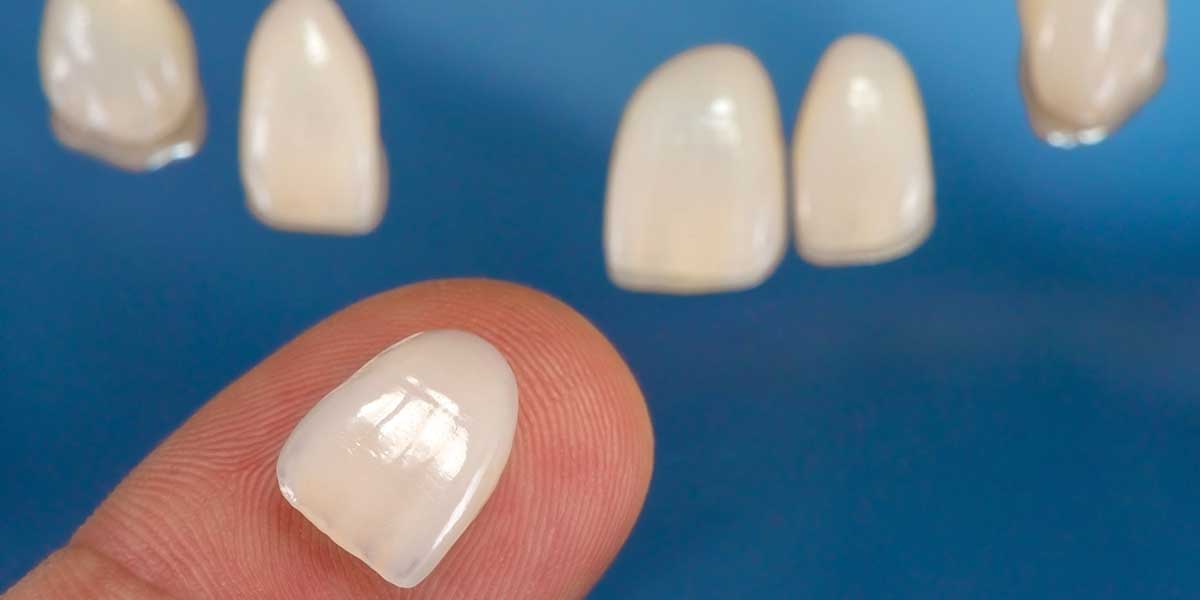Dental Veneers

Veneers are a natural-looking cosmetic treatment that can provide a dramatic smile makeover.
Veneers can be applied to one or several teeth for any of the following aesthetic reasons:
- Correct gaps between the teeth
- Correct uneven lengths
- Correct slightly misaligned teeth
- Correct discoloration
- Restore chipped teeth
- Correct teeth that are slightly crooked
- Change the size or shape
Veneers cover the front of the tooth surface and slightly wrap around the sides and biting edge of the tooth. In most cases, each tooth receiving a veneer will be carefully prepped prior to the veneer fabrication and placement. This preparation involves removing a thin (usually less than one millimeter) layer of enamel from the natural tooth in the areas that will be covered by the veneer. This allows the veneer to fit seamlessly with the contours of the natural tooth. The veneers are attached using a thin but strong bonding material. The material hardens when cured by a specialized light.
There are several types of veneers:
Porcelain Veneers
Porcelain veneers are the longest-lasting and most aesthetically-pleasing type of veneer. They are created in a lab to the exact specifications of the dentist and mimic the look of natural enamel, using multiple thin layers of porcelain. The size, color, shape, and fit are fully customized.
Composite Veneers
Made using composite resin, these may be made in the dental office or in a dental lab and are less expensive than porcelain veneers. They can alter the appearance of tooth color, size, or shape and can be an effective solution for less extensive cosmetic improvements. They are fully customized as are the porcelain veneers, but the composite material is somewhat susceptible to staining and does not last as long as porcelain.
Instant Veneers
Prefabricated resin veneers are not customized to the shape and fit of your teeth, although they do come in different sizes and shapes. We do not recommend instant veneers because they do not provide the appearance, quality, or durability of custom veneers.
Laminate Veneers Questions
What is the difference between a laminate and a veneer?
A laminate, a veneer, and a laminate veneer are exactly the same thing. It is a thin, fingernail-like covering that is cemented over the face side of the natural tooth to improve aesthetics, tooth position, and address possible decay or a fracture.
How much do laminate veneers cost in New York City?
Laminate veneers in New York City cost anywhere in the range of $800–$4500 per tooth, depending on a dentist’s expertise and training. This does not include any additional treatments such as soft tissue procedures (crown lengthening or gingivectomy) or bonding on adjacent teeth in conjunction with the laminate veneers.
What are laminate veneers made of?
Laminate veneers are made with a biocompatible ceramic material like porcelain or e.max. With its translucent properties, porcelain looks quite natural, but it is weak and may be prone to fracture in patients with excessive biting forces. On the other hand, e.max is a lithium disilicate, which is aesthetic, translucent, and has four times the strength of porcelain. In most cases, dentists and patients prefer e.max as the material of choice for laminate veneers.
How long does it take to have laminate veneers done in my mouth?
The complete laminate veneer treatment for 10 teeth usually requires two longer appointments (3 hours each) and one shorter follow up visit (15–20 minutes). The first visit includes the preparation, impression making, and provisionalization of the 10 teeth. The second visit, which is slightly shorter than the first visit, involves the removal of the provisionals and cementation of the definitive laminate veneers. In most cases, a short post-insertion appointment to evaluate the gingival tissues is recommended two weeks after cementation.
Do laminate veneers ever break or come off?
Yes, but rarely. Laminate veneers are usually stronger than your own teeth and exhibit excellent bond strength to the enamel. If they break or fracture, it is usually due to teeth grinding (bruxism), thin or weak ceramic material, or misalignment of the bite. Debonding, a term used to describe when the laminate comes off, is usually due to contamination during the cementation process or insufficient bonding surface on the prepared tooth.
How often do I need to replace the laminate veneers?
Usually every 12–15 years, depending on the amount of gingival recession that has occurred over time. If little to no gingival recession has occurred, laminate veneers can last 30 years or more. In most cases, patients replace the laminate veneers due to recession which exposes dark, unsightly root surfaces near the gumline.
Why should I bleach my teeth before getting laminate veneers?
If a patient’s natural teeth are darker than the desired shade, we often recommend bleaching their teeth prior to laminate veneer treatment. We advise bleaching the teeth for two reasons: first, the patient may be content with their tooth shade after the bleaching process and not require the laminate veneers after all; second, it will lighten the underlying tooth structure prior to placing the new veneers. Since the most aesthetic laminates are translucent like natural teeth, we prefer starting out with a lighter underlying tooth shade instead of a darker one for the best possible results.
What is the difference between a crown and a laminate veneer?
A crown is a covering or replacement tooth that is placed over the entire natural tooth to protect it from decay or fracture. A crown usually requires the removal of the entire enamel layer of the natural tooth. A laminate veneer only requires 0.5mm removal of the enamel layer on the facial and incisal (face and biting) surfaces in most cases. A laminate preparation is more conservative compared to a crown preparation, leaving the integrity of the underlying tooth structure preserved. Laminate veneers after cementation are usually stronger and more aesthetic than their crown counterpart. However, if a tooth is severely broken down due to decay or fracture, a crown is the prudent choice.
Why are laminate veneers so expensive?
Laminate veneers are expensive due to high dental laboratory costs and the dentist’s ability to satisfy the patient’s aesthetic demands. To achieve natural and functional results, patients should select a restorative dentist (preferably a prosthodontist) with extensive training in aesthetics and smile design. It is often difficult to find a dentist with expertise in laminate veneer treatment. Many restorative dentists offer laminates in their practices, but often achieve unsightly results which appear too white, monochromatic, and bulky. A skilled dentist will always contract the services of a master dental technician to fabricate natural-looking, strong restorations. The highest quality laminate veneers are also the most expensive because of the artistry, precision, and back-and-forth communication required between dentist, technician, and patient to produce aesthetic results.
